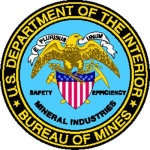- Branche: Mining
- Number of terms: 33118
- Number of blossaries: 0
- Company Profile:
The U.S. Bureau of Mines (USBM) was the primary United States Government agency conducting scientific research and disseminating information on the extraction, processing, use, and conservation of mineral resources.
Founded on May 16, 1910, through the Organic Act (Public Law 179), USBM's missions ...
A dense-media process in which a dry, specific-gravity separation of coal from refuse is achieved by utilizing a flowing dense medium intermediate in density between coal and refuse. The dense medium is formed by bubbling air through a mass of dry sand, 30 to 80 mesh in size. The air dilates and fluidizes the sand mass, causing it to behave 1281 somewhat as a heavy liquid. The coal floats on the aerated sand mass and the refuse sinks.
Industry:Mining
A dense-media process in which a dry, specific-gravity separation of coal from refuse is achieved by utilizing a flowing dense medium intermediate in density between coal and refuse. The dense medium is formed by bubbling air through a mass of dry sand, 30 to 80 mesh in size. The air dilates and fluidizes the sand mass, causing it to behave 1281 somewhat as a heavy liquid. The coal floats on the aerated sand mass and the refuse sinks.
Industry:Mining
A dense-media process in which coal is separated from refuse in an artificial dense medium of sand suspended in water. The specific gravity of this medium is such that the merchantable coal floats while the refuse sinks to the bottom, the separation being analogous to that of a float-and-sink separation with a heavy liquidlike zinc chloride. Named after Thomas M. Chance, U.S. mining engineer.
Industry:Mining
A dense-media process in which large-size coal is separated from the refuse in a flowing bed of small coal in a reciprocating launder. Refuse sinks to the bottom. The small coal is screened from the coarse refuse and returned to the head of the launder by a drag conveyor. The floating large coal passes over skimmers in the trough to the discharge chute.
Industry:Mining
A density current in water, air, or other fluid, caused by different amounts of matter in suspension, such as a dry-snow avalanche or a descending cloud of volcanic dust; specif. a bottom-flowing current laden with suspended sediment, moving swiftly (under the influence of gravity) down a subaqueous slope and spreading horizontally on the floor of the body of water, having been set and/or maintained in motion by locally churned- or stirred-up sediment that gives the water a density greater than that of the surrounding or overlying clear water. Such currents are known to occur in lakes, and are believed to have produced the submarine canyons notching the continental slope. They appear to originate in various ways, such as by storm waves, tsunamis, earthquake-induced sliding, tectonic movement, oversupply of sediment, and heavily charged rivers in spate with densities exceeding that of sea-water. The term is applied to a current due to turbidity, not to one showing that property.
Industry:Mining
A density current in water, air, or other fluid, caused by different amounts of matter in suspension, such as a dry-snow avalanche or a descending cloud of volcanic dust; specif. a bottom-flowing current laden with suspended sediment, moving swiftly (under the influence of gravity) down a subaqueous slope and spreading horizontally on the floor of the body of water, having been set and/or maintained in motion by locally churned- or stirred-up sediment that gives the water a density greater than that of the surrounding or overlying clear water. Such currents are known to occur in lakes, and are believed to have produced the submarine canyons notching the continental slope. They appear to originate in various ways, such as by storm waves, tsunamis, earthquake-induced sliding, tectonic movement, oversupply of sediment, and heavily charged rivers in spate with densities exceeding that of sea-water. The term is applied to a current due to turbidity, not to one showing that property.
Industry:Mining
A department for the purpose of planning adequate and economic ventilation for all future projects and to provide frequent information on existing ventilation systems.
Industry:Mining
A department that deals with all aspects of mine safety and safety training.
Industry:Mining
A deposit composed of sapropel (dominant) and remains of calcareous algae.
Industry:Mining
A deposit due to the detrital accumulation of organic material, as in the cases of limestones and coal.
Industry:Mining
